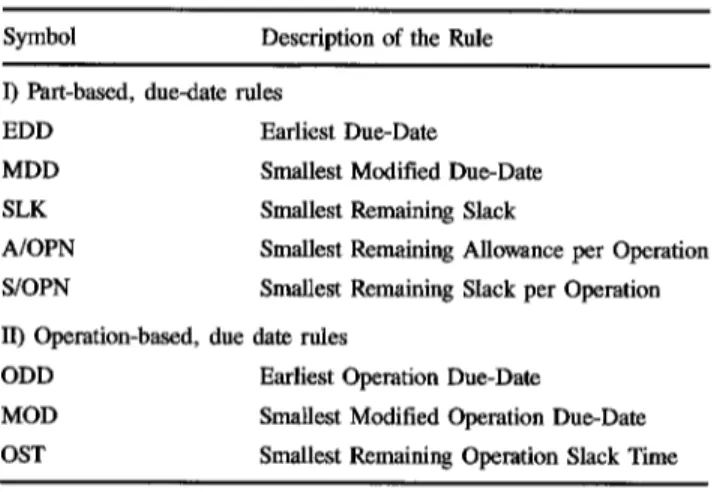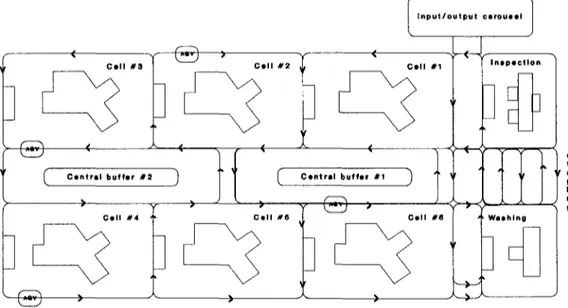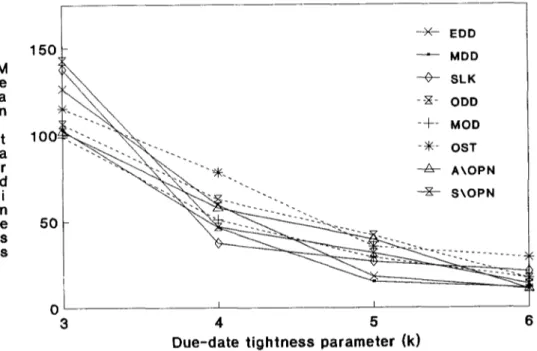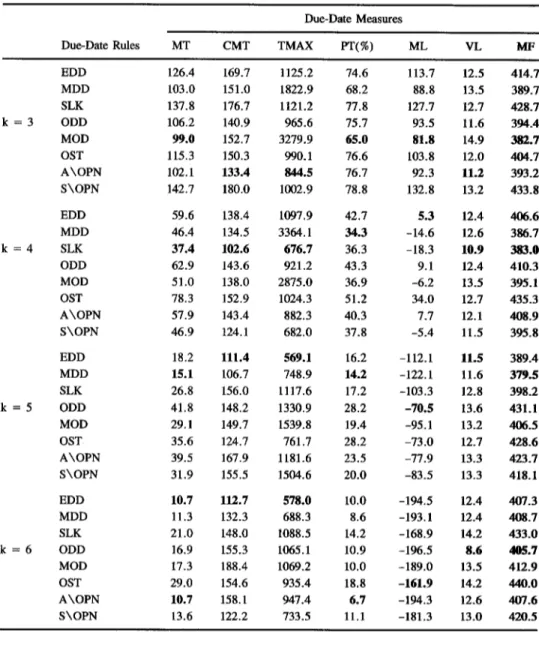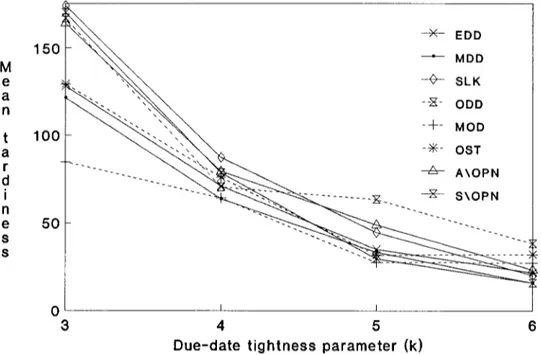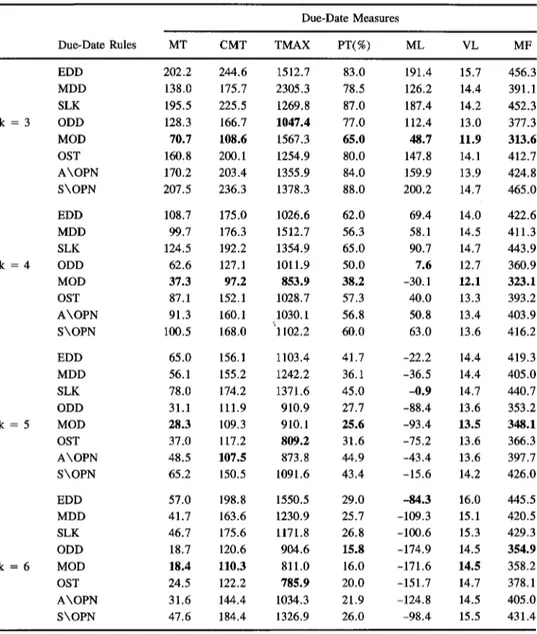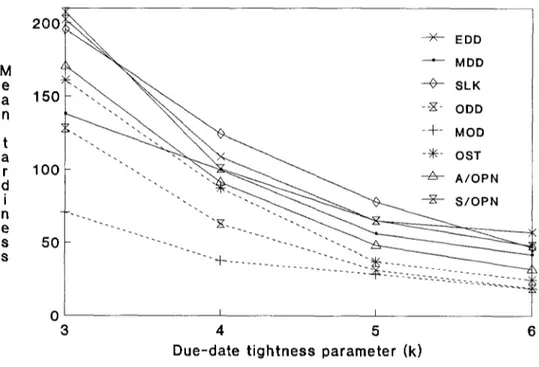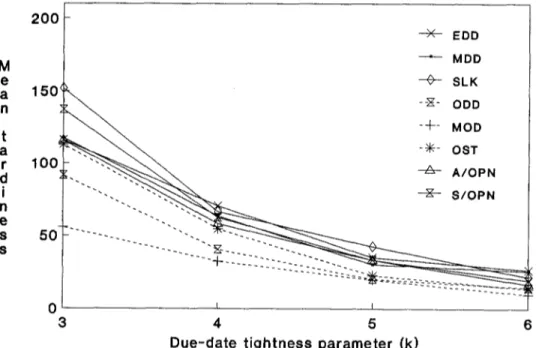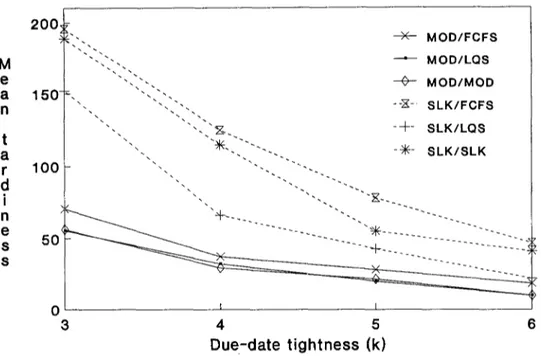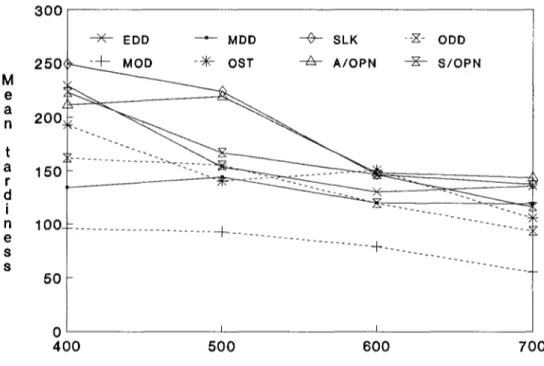The International Journal of Flexible Manufacturing Systems, 5 (1993): 301-323 © 1993 Kluwer Academic Publishers, Boston. Manufactured in The Netherlands.
Experimental Investigation of an FMS Due-date
Scheduling Problem: Evaluation of Machine and
AGV Scheduling Rules
IHSAN SABUNCUOGLU
Department of Industrial Engineering, Bilkent University, Ankara, Turkey 06533 DON L. HOMMERTZHEIM
Department of Industrial Engineering, Wichita State University, Wichita, KS 67208
Abstract. Although extensive research has been conducted to solve design and operational problems of automated manufacturing systems, many of the problems still remain unsolved. This article investigates the scheduling pro- blems of flexible manufacturing systems (FMSs). Specifically, the relative performances of machine and automated ~tided vehicle (AGV) scheduling rules are analyzed against various due-date criteria. First, the relevant literature is briefly reviewed, and then the rules are tested under different experimental conditions by using a simulation model of an FMS. The sensitivity to AGV workload, buffer capacity, and processing-time distribution is also investigated to assess the robustness of the scheduling rules.
Key Words: flexible manufacturing systems, automated guided vehicles, scheduling, dispatching, simulation.
1. Introduction
Today, flexible manufacturing systems (FMSs) seem to be a very promising technology, as they provide flexibility which is essential for many manufacturing companies to stay competitive in a highly dynamic and changing manufacturing environment. Existing FMS implementations have already demonstrated a number of benefits in terms of cost reduc- tions, increased utilizations, reduced work-in-process levels, etc. However, there are a number of problems faced during the life cycle of an FMS. These problems are classified by Ste~ke (1985) into: design, planning, scheduling, and control problems. This article is primarily concerned with scheduling problems of FMSs.
In general, scheduling problems of FMSs are more difficult than traditional job-shop problems due to considerations of the additional resource constraints (i.e., materials handl- ing, limited in-process buffer spaces, etc.). Furthermore, the dynamic nature of an FMS amplifies these problems. In the literature, there are also a number of studies and pro- posed solution approaches ranging from analytical techniques to simulation and artificial intelligence (Raman, Talbot and Rachamadugu 1986; Seidmann and Tenenbaum 1986; Kusiak and Chen 1988; Hutchinson, Leong, Synder and Ward 1989; Sabuncuoglu and Hommertz- heim 1989b, 1992b). While the research in each direction is necessary for better under- standing and better solution of FMS problems, this article focuses on simulation-based
302 I. SABUNCUOGLU AND D. HOMMERTZHEIM
experimental studies of the FMS scheduling problem. Specifically, FMS due-date scheduling rules are compared by using several due-date related criteria under a wide variety of ex- perimental conditions.
The benefit of this research can be summarized as follows. First of all, scheduling rules are widely used in practice for situations ranging from direct use as scheduling heuristics to indirect use as a part of knowledge-bases of expert systems or static-schedule-generation schemes. However, there is only nominal information available about their individual per- formance against due-date related criteria. In these respects, the results of this research will aid in defining their effects. Second, in most of the simulation studies of FMS scheduling rules, only machines are considered, while the materials handling aspect of FMSs are ig- nored. Since AGV rules are also considered in this research, the results of this article can provide a better insight into the impact of an AGV system on the FMS scheduling problem. The remainder of the article is organized as follows. In Section 2, a survey of relevant literature is presented. This is followed in Section 3 by a presentation of system considera- tions, a description of the simulation model used, and underlying assumptions. In Section 4, the relative performances of scheduling rules are measured under a wide variety of con- ditions. Finally, concluding remarks are made in section 5.
2. Literature review: scheduling criteria and rules with due-dates
As reported by Smith, Ramesh, Dudek and Blair (1986), meeting due-dates is one of the most important scheduling criteria used in various existing FMS implementations. However, it is very difficult to fmd a compromise of due-date performances from the wide variety of measures used in industry. In general, the FMS scheduling problem is multi-objective, and the selection of these measures depends on various factors, such as characteristics of parts, lead-time considerations, as well as the overall objectives of a company.
Besides the problem of selecting an appropriate performance measure, there are also additional complications due to setting appropriate due-dates for the parts. When due-dates are dictated by the customer, the approach involved is called exogenous due-date assign- ment. At other times, when due-dates are totally under the control of a company, which sets them based on expected completion time of parts, the setting is called endogenous due-date assignment.
In general, the due-date of a part is determined by allocating a reasonable amount of time (a flow allowance) for the performance of various associated activities (i.e., process- ing, materials handling, waiting, etc.). This amount of budgeted time is also an indicator of the level of due-date tightness. There are various approaches to setting due-dates rang- ing from analytical algorithms to simple rules (Smith and Seidmann 1983). In this article, both endogenous and exogenous due-date assignment procedures are considered.
Endogenous due-date assignment rules were extensively investigated in job-shop en- vironments by Kanet and Christy (1989); Baker (1984); and Baker and Kanet (1983, 1984). Sabuncuoglu and Hommertzheim (1990) also reviewed due-date assignments in the con- text of an FMS and found the TWK (total work content) due-date assignment rule to be the best rule. Their results were consistent with the findings of previous job-shop studies.
EXPERIMENTAL INVESTIGATION OF AN FMS DUE-DATE SCHEDULING PROBLEM 303
Once the due-date is set, it represents the part-based due-date. Since each part may re- quire several operations provided by different machines, operation-based due-dates can also be determined by allocating the original flow allowance among the operations associated with the part. In the scheduling literature, operation-based due-date assignment was in- vestigated by several researchers (Baker 1984; Baker and Kanet 1983; Kanet and Hayya 1982). Their results indicate that the operation-based due-date assignment rules produce better due-date performances than the part-based versions.
After the due-dates are set, they represent the planned departure date of the parts from the system. Thus, the objective of the scheduling system is to find the best production schedule to process all parts so as to meet these dates. There are a number of scheduling rules that attempt to achieve this goal. These scheduling rules use priorities calculated from due-date information. Thus, the parts are scheduled on the machines based on these urgency parameters. Most of them have been tested in job-shop environments (Baker 1984; Baker and Kanet 1983; Conway, Maxwell and Miller 1967). The results are mixed; however, there is an indication that the operation-based, due-date rules perform better than the part-based versions.
In the FMS scheduling literature, Montazeri and Wassenhove (1989) investigated the per- formance of several slack-based, due-date rules. Their conclusion is that S/OPN (Smallest Remaining Slack per Operation) performs better than other due-date scheduling rules. Choi and Malstrom (1988) also tested due-date scheduling rules in an FMS. Their limited supply is based on a comparison of several job-shop scheduling rules using a physical simulator. The results they obtained indicate that SLK (Slack) is the preferred scheduling rule based on various due-date performance measures they employed. However, in their study, the AGV system was not modeled. Furthermore, due-date assignment was not explicitly de- scribed. Han and McGinnis (1989) have also investigated the FMS scheduling problem. The static version of the AGV routing problem was identified as a one-machine, due-date problem. However, throughput was measured as the performance criterion in their study. In this article, machine and material handling aspects of FMSs are considered. Schedul- ing rules are grouped into: (1) machine scheduling and (2) AGV scheduling. The machine scheduling rules are those which are used to select the next part from the input queue upon the availability of the correct machine. AGV rules are used to select the next machine and part to be served upon the availability of an AGV. Machine scheduling rules were selected form the recent FMS and job-shop literature and are listed in table 1. Their mathematical definitions can be found in table 2. The AGV scheduling rules are given in table 3. FCFS (First-Come, First-Served) has the ability to complement the machine scheduling rules by serving a machine with the earliest part completion. The LQS (Largest Queue Size) rule uses information on queue level. This rule was found to be the best AGV rule against the mean flow-time criterion in the previous studies (Sabuncuoglu and Hommertzhiem 1989a, 1992a). Since none of the AGV rules (table 3) utilize due-date information, machine due- date scheduling rules (table 1) are also used as the AGV rules in some of the experiments. The following notation is used in defining the scheduling rules:
i = part index j = operation index
304 I. S A B U N C U O G L U A N D D. H O M M E R T Z H E I M
Table 1. Due-date scheduling rules for machine scheduling. Symbol Description of the Rule I) Part-based, due-date rules
E D D M D D SLK A / O P N S/OPN
1I) Operation-based, due O D D
M O D OST
Earliest Due-Date
Smallest Modified Due-Date Smallest Remaining Slack
Smallest Remaining Allowance per Operation Smallest Remaining Slack per Operation date rules
Earliest Operation Due-Date
Smallest Modified Operation Due-Date Smallest Remaining Operation Slack Time
Table 2. Mathematical definitions of scheduling rules. E D D : D i M O O : max(Di, t + Pj) S L K : D i - t - Pj A / O P N : (D i - t) / n i S / O P N : (D i - t - P j ) / n i O D D : di, i M O D : m a x (di,j, t + Pi,j) OST : di, j - t - Pi,j
Table 3. AGV scheduling rules. FCFS
LQS
(First-Come, First-Served)
(Largest Queue Size, including incoming and outgoing parts)
D i = due-date of part i
di,j = due-date of part i for operation j Ri = ready time or arrival time of part i ci = completion time o f part i
k = allowance factor or measure of due-date tightness ni = remaining number of operations of part i Pi,j = operation time for jth operation of part i Pi = total operation time of part i
F i = C i - R i ( f l o w t i m e o f part i) Li = Ci - Di (lateness of part i)
EXPERIMENTAL INVESTIGATION OF AN FMS DUE-DATE SCHEDULING PROBLEM 305
Due-dates are assigned by the TWK rule, because this rule has been found to be quite robust in previous studies (Kanet and Christy 1989; Sabuncuoglu and Hommertzheim 1990). By using this rule, due-dates were determined as shown below:
D i = R i + k*P i (1)
d i j = d i j - 1 + k*pi.j (2)
3. System considerations, simulation model, and experimental conditions
Figure 1 shows the layout of the hypothetical FMS studied in this research. In this system, there are six machining centers, one inspection station, one washing station, and one in- put/output carousel. Each machining center has a finite input/output buffer space in which parts can wait before and after an operation. There are also two central buffer areas at which parts are temporarily stored to prevent system locking. Parts are transferred in the system by an AGV system. Each AGV moves a part between the machines along a predeter- mined and unidirectional path. Upon completion of a part transfer, an idle AGV either returns to the staging area or stays at the same station for the next journey, depending upon the current operating policy. As far as the link between the workstations and the AGVs is concerned, a direct-access, part-retrieval design is considered to be operational. Therefore, any part from the queue can be retrieved regardless of its position in the queue. A simulation model of the FMS described above was developed in SIMAN (Pegden 1985).
I
lnput/output carousel 1Cell #3 Coil #2 Cell #1
• < ( <
C Control buffer #2 ~ ~ Control buffer ,1
306 I. SABUNCUOGLU AND D. HOMMERTZHEIM
Parts arrive according to the Poisson process. It is assumed that all design and planning (i.e., allocation of tools, process plans, and routing of parts) issues, as suggested by Steeke (1985), have already been resolved. Each part is processed by a series of machines. The number of operations is determined by a discrete, uniform distribution between one and six. The arriving parts are held in a load/unload area (or carousel) and are allowed into the system on a FCFS basis, as long as both an AGV and one queue space at the respective machines are available. The machine assignment is random, and no part is allowed to visit the same machine more than once. Besides the machines, all of the parts visit the washing station. However, only 50% of the parts are inspected. Finally, two AGVs are employed in the model.
The scheduling rules are tested under the following experimental conditions. They are as follows:
- - different distribution type and parameters for processing times (i.e., exponential and normal distributions)
- - varying machine and AGV load levels - - different queue capacities and AGV speeds - - varying levels of due-date allowances.
For the operation-time distribution, both exponential and normal distributions are used. Since the normal distribution is one of the distributions for which the variance is indepen- dent of the mean, it allows the analyst to control the variability in the system. In the ex- periments, only positive values are considered for the normally distributed processing times. A common random-number, variance-reduction technique was implemented to compare the rules under identical conditions and to reduce the simulation run length. Furthermore, in order to obtain consistent samples from the simulation model, the parts were numbered in the order of their arrival, and the statistics were updated for those numbered parts. Based on pilot runs, which determined the transient period, statistics for the first 300 parts were discarded and samples collected for only the parts numbered between 301 and 3300.
4. Simulation results
The due-date performance of the eight due-date scheduling rules are analyzed under dif- ferent experimental conditions. First, the rules are compared using the normally distributed processing times. Then the experiments are repeated using the exponential distribution.
4.1. Analysis of the due-date scheduling rules using normally distributed processing times
The FMS model was simulated at varying allowance levels (or due-date tightness) ranging from very tight (k = 3) to very loose (k = 6). In the experiments, due-date scheduling rules (given in table 1) were used as the machine-schednling rules. The average utiliTation rates of the machines and the AGV system were approximately 85 and 87.5 %, respectively. Although the primary performance measure was mean tardiness (MT), other due-dam
EXPERIMENTAL INVESTIGATION OF AN FMS DUE-DATE SCHEDULING PROBLEM 307
performances were also measured. These are: maximum tardiness (TMAX), mean- conditional tardiness (MCT), mean lateness (ML), standard deviation of lateness (VL), proportion of tardy parts (PT), and mean flow-time (MF).
Since it is very difficult to investigate the performance of the rules under all possible combinations of these factors (i.e., the combinatorial nature of the problem), changes in the conditions were made one at a time. Thus, in conducting experiments, first the rules were compared under standard (or base) conditions, and then simulation experiments were repeated by varying the conditions. Although some of the results are given in tables, most of the results are summarized in figures, in order to show the behavior of rules at varying conditions.
Figure 2 displays mean-tardiness performances of the eight machine scheduling rules when FCFS was the AGV rule. Table 4 summarizes the results for all due-date performance measures (the minimum values are boldfaced). In general, the results are quite mixed. No single rule dominates other rules. Their performances change as the due-date tightness varies. In conclusion, there is not a single rule which optimizes all due-date performance measures. The same type of crossover effect can also be observed when LQS was used as the AGV rule (figure 3). Only MOD produces slightly better due-date performance when the due- date is tight (k = 3). But, in the rest of the conditions, neither MOD nor the other rules yield superior results. However, it can be noticed that the resulting mean tardiness perfor- mance of rules is better, as compared to the previous case. This is because LQS is a better rule than FCFS for minimizing mean flow-time (Sabuncuoglu and Hommertzheim 1992a). Thus, better flow-time performance can also improve due-date performances, especially
at tight due-dates. M e a n t a r d i n e s s 150 10C 50 0 3 - ~ - - EDD i • MDD 0 SLK o ° ° I I 4 5 6 D u e - d a t e t i g h t n e s s p a r a m e t e r ( k ) Figure 2. Normal with FCFS rules.
3 0 8 I. SABUNCUOGLU AND D. HOMMERTZHEIM
Table 4. Due-date performance of the scheduling rules at varying due-date tightness, parameter (k) (FCFS is the AGV rule).
Due-Date Measures
Due-Date Rules MT CMT TMAX PT(%) ML VL MF
EDD 126.4 169.7 1125.2 74.6 113.7 12.5 414.7 MDD 103.0 151.0 1822.9 68.2 88.8 13.5 389.7 SLK 137.8 176.7 1121.2 77.8 127.7 12.7 428.7 k = 3 ODD 106.2 140.9 965.6 75.7 93.5 11.6 394.4 MOD 99.0 152.7 3279.9 65.0 81.8 14.9 382.7 OST 115.3 150.3 990.1 76.6 103.8 12.0 404.7 A \ O P N 102.1 133.4 844.5 76.7 92.3 11.2 393.2 S\OPN 142.7 180.0 1002.9 78.8 132.8 13.2 433.8 EDD 59.6 138.4 1097.9 42.7 5.3 12.4 406.6 MDD 46.4 134.5 3364.1 34.3 -14.6 12.6 386.7 k = 4 SLK 37.4 102.6 676.7 36.3 -18.3 10.9 383.0 ODD 62.9 143.6 921.2 43.3 9.1 12.4 410.3 MOD 51.0 138.0 2875.0 36.9 -6.2 13.5 395.1 OST 78.3 152.9 1024.3 51.2 34.0 12.7 435.3 A \ O P N 57.9 143.4 882.3 40.3 7.7 12.1 408.9 S\OPN 46.9 124.1 682.0 37.8 -5.4 11.5 395.8 EDD 18.2 111.4 569.1 16.2 -112.1 11.5 389.4 MDD 15.1 106.7 748.9 14.2 -122.1 11.6 379.5 SLK 26.8 156.0 1117.6 17.2 -103.3 12.8 398.2 k = 5 ODD 41.8 148.2 1330.9 28.2 -70.5 13.6 431.1 MOD 29.1 149.7 1539.8 19.4 -95.1 13.2 406.5 OST 35.6 124.7 761.7 28.2 -73.0 12.7 428.6 A \ O P N 39.5 167.9 1181.6 23.5 -77.9 13.3 423.7 S\OPN 31.9 155.5 1504.6 20.0 -83.5 13.3 418.1 EDD 10.7 112.7 578.0 10.0 -194.5 12.4 407.3 MDD 11.3 132.3 688.3 8.6 -193.1 12.4 408.7 SLK 21.0 148.0 1088.5 14.2 -168.9 14.2 433.0 k = 6 ODD 16.9 155.3 1065.1 10.9 -196.5 8.6 41~.7 MOD 17.3 188.4 1069.2 10.0 -189.0 13.5 412.9 OST 29.0 154.6 935.4 18.8 -161.9 14.2 440.0 A \ O P N 10.7 158.1 947.4 6.7 -194.3 12.6 407.6 S\OPN 13.6 122.2 733.5 11.1 -181.3 13.0 420.5 T h e s i m u l a t i o n e x p e r i m e n t s w e r e a l s o r e p e a t e d u s i n g t h e d u e - d a t e r u l e s as t h e A G V r u l e s . I n t h i s c a s e , t h e s a m e d u e - d a t e s c h e d u l i n g r u l e w a s u s e d a s b o t h m a c h i n e a n d A G V r u l e s . B u t n o s i n g l e r u l e i m p r o v e s m e a n t a r d i n e s s n o t i c e a b l y ( f i g u r e 4). I n t h e p r e v i o u s s i m u l a t i o n s t u d i e s ( S a b u n c u o g l u a n d H o m m e r t z h e i m 1 9 9 0 , 1 9 9 2 a ) , i t is n o t e d t h a t t h e v a r i a n c e o f t h e p r o c e s s i n g t i m e is a n i m p o r t a n t f a c t o r i n t h e r e l a t i v e p e r - f o r m a n c e o f t h e s c h e d u l i n g rules. T h u s t h e e x p e r i m e n t s w e r e r e p e a t e d w i t h h i g h e r v a r i a n c e s f o r t h e p r o c e s s i n g t i m e s ( i . e . , c o e f f i c i e n t o f v a r i a t i o n w a s i n c r e a s e d f r o m 3 0 t o 4 0 % ) .
EXPERIMENTAL INVESTIGATION OF AN FMS DUE-DATE SCHEDULING PROBLEM 309 M e a n t a r d i n e S S 1 5 0 100 50 0 EDD MDD 0 SLK --~- ODD - q - - MOD - ~ - OST ~.'. ~ A\OPN I . t _ _ - - 3 4 5
Due-date tightness parameter (k) Figure 3. Normal with LQS rules.
M e a n 150
1001
50 0 3 EDD MDD --~- SLK "-•- ODD - J r - - MOD "" " \ ' - \ ~ . ~ A\OPN 1 1-- .... 4 5 6Due-date tightness parameter (k) Figure 4. Normal with AGV due-date rules.
310 I. SABUNCUOGLU AND D. HOMMERTZHEIM
As shown in figure 5, the performances of the rules are quite different at tight due-dates (k = 3), as compared to the first case (figure 2). Specifically, MOD produces lower mean tardiness. However, the differences in their performances diminish as the due-dates are loosened. When the proportion of tardiness is considered, MOD yields consistently better performance than other rules (figure 6).
The above results and further pilot tests using different scheduling criteria indicate that the performance of scheduling rules change as the due-date tightness changes. No single rule dominates other rules. However, MOD has the tendency to improve due-date measures when due-dates are tight and the variance of operation time is high. This difficulty in distinguishing the relative effectiveness of the rules could be due to the variance of the normally distributed processing times. In this case, the due-date assignment procedure (TWK) and the due-date scheduling rules, which are based on the processing times with small variance, would not yield significantly different due-date performances.
4.2. Analysis of the due-date scheduling rules using exponentially distributed processing times
The exponential distribution is a commonly used processing-time distribution in the literature (Baker 1984; Baker and Kanet 1984). In general, the exponential distribution possesses very large variability. It is known from the earlier job-shop studies that the relative perfor- mances of the rules are more significant under high variability. Thus, the objective of this section is to repeat the simulation experiments using the exponential distribution and to observe the differences in performance of rules due to the increased variability. However, during the initial simulation runs, because of this increased variability, the system was saturated for most of the rules. Thus, the machine and AGV load levels were reduced. At the new condition, the mean operation time was reduced from 20.60 to 19.03 minutes, and the AGV speed was increased from 60 to 65 feet/minute, which results in average machine and AGV utilizations of 75 and 82 %, respectively.
The rest of the article is organized as follows. In the next subsection, due-date schedul- ing rules are compared with different AGV rules. In section 4.2.2, the scheduling rules are tested under exogenous due-date assignment. This is followed by comparison of rules at varying system load levels and queue capacities in sections 4.2.3 and 4.2.4, respectively.
4.2.L Due-date scheduling rules with different AGV rules. First, the FMS system was simulated using FCFS as the AGV scheduling rule. From the simulation results presented in table 5, it is obvious that MOD is a very effective rule for the mean-tardiness measure. It outperforms the other rules, especially when the due-dates are tight (i.e., k is small); ODD is next best. Furthermore, operation-based rules perform better than the part-based counterparts.
As depicted in figure 7 (see figure 3 for comparison with the normally distributed case), the differences in the relative performances of rules are more noticeable when due-dates are tight. Also, at tight due-dates (k = 3 and 4), minimizing the mean flow-time results in better due-date performances. Thus, at small values of k, the rule which yields minimum
EXPERIMENTAL INVESTIGATION OF AN FMS DUE-DATE SCHEDULING PROBLEM 311 100 ~" M e a n 5O 0 3 X EDD • MDD ' "~,~'~ 0 SLK - - , - . . . ~ ~ ,A A\OPN I I 4 5 6
Due-date tightness parameter (k)
Figure 5. Normal with FCFS and 40 percent CV rules.
P o 1 0 0 P 0 r t 80~ i 0 n 6 0 4 0 2 0 0 X EDD MDD 0 S L K --X- ODD " " ' - - . ~ . . . . ~- A \ O P N I I 4 5 D u e - d a t e t i g h t n e s s p a r a m e t e r (k) Figure 6 Normal with FCFS and 40 percent CV proportion.
312 I. SABUNCUOGLU AND D. HOMMERTZHEIM
Table 5. Due-date performance of the scheduling rules at varying due-date tightness, parameter (k) under ex- ponentially distributed processing times (FCFS is the AGV rule).
Due-Date Measures
Due-Date Rules MT CMT TMAX PT(%) ML VL MF
EDD 202.2 244.6 1512.7 83.0 191.4 15.7 456.3 MDD 138.0 1 7 5 . 7 2305.3 78.5 126.2 14.4 391.1 SLK 195.5 225.5 1269.8 87.0 187.4 14.2 452.3 k = 3 ODD 128.3 1 6 6 . 7 1047.4 77.0 112.4 13.0 377.3 MOD 70.7 108.6 1567.3 65.0 48.7 11.9 313.6 OST 160.8 200.1 1254.9 80.0 147.8 14.1 412.7 A \ O P N 170.2 203.4 1355.9 84.0 159.9 13.9 424.8 S\OPN 207.5 236.3 1378.3 88.0 200.2 1 4 . 7 465.0 EDD 108.7 1 7 5 . 0 1026.6 62.0 69.4 14.0 422.6 MDD 99.7 1 7 6 . 3 1512.7 56.3 58.1 14.5 411.3 SLK 124.5 1 9 2 . 2 1354.9 65.0 90.7 14.7 443.9 k = 4 ODD 62.6 127.1 1011.9 50.0 7.6 12.7 360.9 MOD 37.3 97.2 853.9 38.2 -30.1 12.1 323.1 OST 87.1 152.1 1028.7 57.3 40.0 13.3 393.2 A \ O P N 91.3 160.1 1030.1 56.8 50.8 13.4 403.9 S\OPN 100.5 1 6 8 . 0 1102.2 60.0 63.0 13.6 416.2 EDD 65.0 156.1 1103.4 41.7 -22.2 14.4 419.3 MDD 56.1 1 5 5 . 2 1242.2 36.1 -36.5 14.4 405.0 SLK 78.0 1 7 4 . 2 1371.6 45.0 -0.9 14.7 440.7 ODD 31.1 111.9 910.9 27.7 -88.4 13.6 353.2 k = 5 MOD 28.3 109.3 910.1 25.6 -93.4 13.5 348.1 OST 37.0 117.2 809.2 31.6 -75.2 13.6 366.3 A \ O P N 48.5 107.5 873.8 44.9 -43.4 13.6 397.7 S\OPN 65.2 1 5 0 . 5 1091.6 43.4 -15.6 14.2 426.0 EDD 57.0 1 9 8 . 8 1550.5 29.0 -84.3 16.0 445.5 MDD 41.7 1 6 3 . 6 1230.9 25.7 -109.3 15.1 420.5 SLK 46.7 1 7 5 . 6 1171.8 26.8 -100.6 15.3 429.3 ODD 18.7 120.6 904.6 15.8 -174.9 14.5 354.9 k = 6 MOD 18.4 110.3 811.0 16.0 -171.6 14.5 358.2 OST 24.5 122.2 785.9 20.0 -151.7 14.7 378.1 A\OPN 31.6 1 4 4 . 4 1034.3 21.9 -124.8 14.5 405.0 S\OPN 47.6 1 8 4 . 4 1326.9 26.0 -98.4 15.5 431.4 f l o w - t i m e a l s o p r o d u c e s m i n i m u m m e a n t a r d i n e s s , m e a n - c o n d i t i o n a l t a r d i n e s s , a n d p r o - p o r t i o n o f t a r d i n e s s . H o w e v e r , as k i n c r e a s e s , t h e d i f f e r e n c e s in p e r f o r m a n c e s o f r u l e s b e c o m e s m a l l e r . A s c a n a l s o b e n o t e d , t h e M O D r u l e , w h i c h is v e r y e f f e c t i v e i n r e d u c i n g t h e m e a n t a r d i - n e s s , a l s o y i e l d s a b e t t e r m e a n l a t e n e s s at t h e t i g h t e r d u e - d a t e s . H o w e v e r , as t h e d u e - d a t e t i g h t n e s s d e c r e a s e s , r u l e s s u c h a O S T , w h i c h y i e l d s p o o r e r m e a n - t a r d i n e s s p e r f o r m a n c e t h a n M O D , r e s u l t in l o w e r m e a n l a t e n e s s . T h i s o c c u r s b e c a u s e f o r l o o s e d u e - d a t e s , p o o r
EXPERIMENTAL INVESTIGATION OF AN FMS DUE-DATE SCHEDULING PROBLEM 313 200 M e a 150 n 100 50 0 X EDD " - ÷ . . .
2222;---~_---
. . . I I 3 4 5 6 Due-date t i g h t n e s s parameter (k) Figure 7. Mean tardiness performances of operaton and job-based due-date.mean-tardiness performance results in a fewer early part completions, at a cost of some tardy parts. Since the marginal gain due to reducing early part completions is greater than the gain obtained by reducing mean tardiness, mean lateness is improved.
Similar observations are made when using LQS as when employing the AGV rule (figure 8). However, due-date performances of the machine scheduling rules with LQS are better than with FCFS (recall that the same type of improvement was also observed with LQS for the normally distributed case). In general, the MOD rule performs better than other rules; ODD is next best. Other rules could not compete successfully with the above rules. Again, operation-based rules are better than the part-based rules.
Similar behavior is also observed when using the same due-date scheduling rule for both the machine and AGV rule (figure 9). MOD and ODD still yield better mean-tardiness performances. Mean-tardiness performances of due-date rules as AGV rules are also bet- ter than the same rules with the FCFS/AGV rule combination. When they are compared to LQS rule combinations, LQS appears to perform better. However, this improvement in tardiness by LQS is not the same for each of the machine scheduling rules. For example, while slack-based rules, which were found to be the best rules in previous FMS studies (Montazeri and Wassenhowe 1989; Choi and Malstrom 1988), improve the mean tardiness with LQS, the same amount of improvement is not observed for MOD rules (figure 10). This interaction effect indicates that marginal improvement by AGV rule is smallest when used with a better machine scheduling rule.
314 I. SABUNCUOGLU AND D. HOMMERTZHEIM M e a n 200 I X EDD " MDD o s r 1 0 0 ~ ~ '~ A/OPN 0 I i 3 4 5
Due-date tightness parameter (k) Figure 8. Mean tardiness performances of operation and job-based due-date.
M e a n 200 150 100 50- X EDD • MDD © SLK . . . " ' - . . . ~ S/OPN I I 3 4 5
Due-date tightness parameter (k) Figure 9. Mean tardiness due date as AGV rules at varying.
EXPERIMENTAL INVESTIGATION OF AN FMS DUE-DATE SCHEDULING PROBLEM 315 M e a n t a r d i n e s s 2 0 0 , 1 5 0
100
~ - . X MOD/FCFS " - . " . " M O D / L Q S.\\\.
0
MOD/MOD -. - --)K- SLK/FCFS ~E.. --l-- SLK/LQS "~" " ' " " --~- SLK/SLK . . . oL__ ~ I 3 4 5 6 D u e - d a t e t i g h t n e s s (k)Figure 10. Mean tardiness due date as AG rules.
4.2.2. Exogenous due-date assignment. Up to this point, it was assumed that due-dates were set by the company, based on expected flow allowances (i.e., endogenous due-date assignment). However, customers can also determine the due-dates which are usually ran- dom in nature. In order to represent this situation, the original due-date assignment method T W K was replaced with a random assignment procedure. According to this procedure, the flow allowance was determined by using the uniform distribution and then added to the total processing times to set the due-dates.
Four different cases were considered. In the first case, the parameters of the uniform distribution were set to 0 and 400, with a range (R) of 400. Later the ranges were increased to 500, 600, and 700. Recall that in these experiments, only the upper limit of the uniform distribution was increased while the lower limit was maintained at zero. Thus, as the range increased, the mean and the variance of the uniformly distributed flow allowances increased. The performances of the due-date scheduling rules under this new due-date assignment procedure are shown in figure 11 and table 6. In general, MOD performs better than other rules. It not only minimizes the mean flow-time considerably but also achieves better due- date performance. The relative performances of other rules vary as the range of uniformly distributed due-dates changes.
4.2.3. Sensitivity of the results to varying machine and AGV load levels. The scheduling rules were also compared at varying machine and AGV load (utilization) levels. Four machine and two AGV load levels were considered (table 7). As before, the rules were compared at varying levels of the tightness parameter (k).
316 1. SABUNCUOGLU AND D. HOMMERTZHEIM M e a n
3oo[
>< EDD " MDD © 8LK --'~'-ODD2 5 0 ~ OST A A/OPN T~ S/OPN
100- 5 0 I 400 I I 500 600 '00 Ranges of u n i f o r m l y d i s t r i b u t e d d u e - d a t e s
Figure 11. Mean tardiness performances exogenous.
The simulation results are displayed in tables 8 and 9 and figure 12. In general, better mean tardiness performances are obtained for each rule when the load level is reduced and/or the due-date tightness parameter is decreased. Also, differences in relative perfor- mances of the rules diminish as the load levels and the flow allowance are reduced. Moreover, the rules perform better with the AGV scheduling rule LQS than with FCFS. Operation- based, due-date scheduling rules, MOD, ODD, and OST, result in better performances than part-based versions of MDD, EDD, and SLK. In mot of the cases, MOD is the preferable rule, followed by ODD and OST. MDD is still a better rule than EDD. EDD and SLK display better results than A/OPN and S/OPN.
4.2.4. Sensitivity of the results to varying queue sizes. The effects of different queue
capacities on the relative performance of due-date scheduling rules were also investigated in this study. Eight scheduling rules were compared at 3 different queue capacities under varying due-date tightnesses.
As shown in table 10, MOD is still the preferable rule. In particular, its performance is the best for the tighter due-dates when the queue capacity is small. In general, MDD performs better than EDD and SLK. It also yields better performance than ODD when due-dates tightness and queue capacity is increased and due-dates are loosened. Again, operation-based rules result in better mean tardiness than their part-based counterparts.
EXPERIMENTAL INVESTIGATION OF AN FMS DUE-DATE SCHEDULING PROBLEM 317
Table 6. Due-date performance of scheduling rules when the due-dates are set by the random due-date assignment Due-Date Measures Due-Date Rules MT C M T T M A X PT(%) ML VL MF EDD 229.0 281.3 1241.5 81.1 210.0 15.7 497.5 MDD 134.5 192.2 2708.9 70.0 108.8 14.9 396.1 SLK 284.8 292.7 1528.9 84.9 233.3 16.1 521.9 ODD 162.0 228.0 1325.9 71.0 131,2 15.2 420.7 R = 400 MOD 95.8 158.1 1326.6 60.1 54.4 13.7 342.6 OST 193.0 254.5 1470.3 75.9 166.6 15.7 456.0 A/OPN 211.7 262.7 1428.1 80.5 191.3 15.7 479.9 S/OPN 223.4 269.2 1207.4 82.9 207.4 16.0 494.5 EDD 153.9 222.7 1438.3 69.1 111.8 15.1 453.3 MDD 144.3 220.9 2273.5 65.3 103.9 16.1 443.2 SLK 223.9 291.2 1945.6 76.9 196.3 17.1 534.1 R = 500 ODD 155.7 236.1 1257.4 60.5 108.2 15.6 446.0 MOD 92.6 170.8 1820.3 54.1 27.9 14.7 366.8 OST 140.5 212.2 1289.7 66.1 94.1 15.2 431.2 A/OPN 219.5 286.6 1900.5 76.5 190.8 17.1 528.5 S/OPN 167.1 221.7 1204.6 75.5 136.9 14.9 475.5 EDD 130.2 209.7 1407.7 62.2 72.8 15.3 459.1 MDD 120.2 213.6 1913.4 56.3 56.3 16.2 445.4 SLK 146.6 228.8 1485.9 64.1 92.7 15.9 480.8 ODD 119.8 211.4 1337.9 56.3 45.9 15.9 435.0 R = 600 MOD 79.1 171.7 1297.1 46.0 -12.8 15.2 376.7 OST 150.8 246.7 1391.5 61.3 84.5 16.7 473.2 A/OPN 148.6 228.4 1644.3 64.9 98.7 16.2 448.6 S/OPN 146.8 220.1 1398.8 66.4 96.1 16.1 485.7 EDD 146.0 253.4 1581.4 57.7 69.6 17.1 508.3 MDD 119.4 228.3 1609.5 52.2 38.4 17.0 447.2 SLK 137.9 233.1 1403.3 58.8 64.2 16.5 504.7 ODD 93.3 198.0 1094.0 47.0 -15.9 16.2 422.4 R = 700 MOD 55.2 147.1 1442.4 37.4 -71.0 10.6 364.6 OST 105.7 206.7 1391.3 51.0 5.1 16.5 446.7 A/OPN 144.1 241.2 1566.4 59.7 77.9 16.7 513.4 S/OPN 116.2 208.0 1270.2 56.0 41.8 15.9 480.2
Table 7. Experimental conditions for testing scheduling rules under varying load levels (utilization levels). Machine Load Levels (%)
AGV Load
Input Parameter Levels (%) 77.5 75 70 65
Mean operation 70.0 19.03 19.03 19.03 19.03 time (min) 82.5 19.03 19.03 19.03 19.03 Interarrival time 70.0 14.50 15.00 16.00 17.00 (min) 82.5 14.50 15.00 16.00 17.00 AGV speed 70.0 82.50 78.00 71.00 65.50 (ft/min) 82.5 68.50 65.00 59.30 55.00
318 I. SABUNCUOGLU AND D. HOMMERTZHEIM
TabN R Mean-mrdiness performance ofdue-dateschedulingrules w~h FCFSand LQS AGVrules(AGVutiliza- f i o n ~ 8 2 . 5 % ) .
Machine Load Levels (%)
77.5 75 70 65 Rules k FCFS LQS FCFS LQS FCFS LQS FCFS LQS 3 298.1 172.6 202.2 116.3 107.9 84.2 76.1 61.7 4 249.4 103.7 108.7 70.3 65.2 43.0 38.1 28.6 EDD 5 167.5 55.9 65.0 35.1 26.9 20.3 16.0 14.7 6 82.1 34.0 57.0 26.6 14.1 12.5 9.3 8.0 3 191.0 130.3 138.0 117.7 85.5 53.2 64.6 51.5 4 126.3 87.5 99.7 63.1 42.7 35.0 30.0 25.8 MDD 5 103.4 49.3 56.1 30.3 28.5 17.4 15.6 13.8 6 61.9 36.7 41.7 25.9 16.7 12.0 9.3 8.0 3 285.8 182.6 195.5 152.1 121.6 92.1 78.2 66.5 4 190.7 114.6 124.5 66.3 59.8 41.9 36.0 31.7 SLK 5 96.7 62.4 56.1 42.7 32.8 21.9 17.8 17.6 6 46.7 37.2 41.7 21.9 17.7 13.3 9.5 8.0 3 188.4 114.6 128.3 91.4 76.1 61.5 49.8 42.7 4 85.5 53.3 62.6 40.3 29.9 27.5 22.5 19.6 ODD 5 60.5 31.8 31.1 20.3 17.2 11.3 9.4 8.4 6 43.6 21.8 18.2 14.6 9.8 6.8 5.9 4.4 3 90.9 66.2 70.7 55.6 45.5 40.0 40.2 30.0 4 54.5 41.0 37.3 32.3 23.1 19.5 18.1 13.2 MOD 5 41.9 29.9 28.3 19.8 12.5 11.8 9.1 7.4 6 39.2 15.9 18.4 9.9 9.7 7.0 5.7 4.7 3 261.5 134.5 160.8 112.9 83.5 78.3 65.6 54.2 4 116.7 77.7 87.1 54.5 35.3 29.7 30.2 21.4 OST 5 66.7 37.2 37.0 22.8 19.0 12.6 11.2 8.0 6 38.2 21.3 24.6 14.0 9.9 8.6 6.6 4.9 3 288.0 170.5 170.2 115.9 112.3 84.8 62.6 55.9 4 182.3 90.9 91.3 58.0 49.3 39.2 32.2 22.3 A/OPN 5 167.7 49.5 48.4 33.5 22.4 15.5 12.3 10.8 6 51.8 32.5 31.7 16.9 14.2 10.6 8.6 7.0 3 312.6 163.2 207.5 137.3 101.0 92.9 91.0 64.3 4 295.7 102.1 105.5 62.2 47.9 43.7 31.0 29.7 S/OPN 5 169.5 52.9 65.2 33.5 27.3 18.3 16.5 13.3 6 101.3 35.6 47.6 19.6 14.2 10.2 8.8 7.0 7 55.5 22.4 29.0 13.8 11.1 7.6 5.4 4.6
EXPERIMENTAL INVESTIGATION OF AN FMS DUE-DATE SCHEDULING PROBLEM 319
Table 9. Mean-tardiness performance of machine scheduling rules with FCFS and LQS AGV rules (AGV utiliza- tion at 70%).
Machine Load Levels (%)
77.5 75 70 65 Rules k FCFS LQS FCFS LQS FCFS LQS FCFS LQS 3 251.3 142.3 144.8 108.7 81.4 66.3 50.5 47.2 4 145.8 8 5 . 5 82.7 59.5 43.8 32.3 21.8 19.3 EDD 5 90.7 43.2 45.8 31.4 17.3 14.5 11.4 5.1 6 57.3 23.0 30.7 15.1 7.9 8.6 4.3 4.4 3 151.2 120.3 116.1 89.0 63.6 62.2 42.3 38.4 4 112.9 68.7 58.9 48.7 41.8 28.5 22.0 17.3 M D D 5 63.7 43.6 40.3 30.9 14.7 11.0 10.0 5.4 6 38.0 25.4 24.2 15.8 8.3 7.8 4.5 4.3 3 237.0 159.2 147.6 125.2 84.4 73.5 58.0 54.3 4 168.5 95.7 92.0 63.7 39.0 33.9 22.8 23.7 SLK 5 70.0 54.6 40.7 32.9 16.3 17.9 10.5 5.1 6 44.4 28.3 21.1 16.2 7.9 9.2 6.1 5.7 3 159.3 115.4 106.8 82.6 56.6 46.5 32.9 29.7 4 65.0 51.6 44.7 34.6 19.6 18.3 10.3 10.7 ODD 5 39.8 21.5 19.8 14.9 8.8 7.1 4.4 3.5 6 26.8 14.7 13.8 11.4 4.9 4.5 2.6 2.7 3 90.9 51.7 45.8 42.7 31.7 29.8 22.1 21.8 4 42.6 37.8 27.3 26.5 16.0 13.5 8.8 8.3 MOD 5 29.7 20.4 17.1 13.5 6.8 6.7 4.7 3.7 6 18.7 13.6 10.9 8.7 4.1 4.3 2.6 2.4 3 186.4 128.6 145.5 91.6 69.5 60.5 45.8 41.8 4 92.0 64.0 46.8 39.7 25.6 18.8 14.6 12.9 5 48.2 23.6 21.6 19.3 7.9 9.5 5.5 4.9 6 28.9 17.1 11.9 10.1 7.2 5.7 4.0 3.3 3 181.4 128.4 134.3 106.1 74.8 62.0 44.7 40.0 4 141.3 78.2 71.9 49.8 27.0 26.3 15.5 14.0 A/OPN 5 72.5 39.5 52.1 19.2 13.8 13.1 6.7 6.8 6 30.0 20.5 20.8 13.5 7.5 6.6 4.4 3.3 3 204.1 155.5 146.9 116.5 85.1 72.5 52.6 48.8 4 201.1 89.1 70.5 57.4 36.8 26.7 19.0 17.4 S/OPN 5 84.9 38.4 41.3 24.0 14.1 12.7 9.1 8.0 6 74.0 22.3 22.1 16.7 7.6 6.9 5.3 4.7
320 I. SABUNCUOGLU AND D. HOMMERTZHEIM 3 5 0 M e a n 3 0 0 2 5 0 2 0 0 150 100 5 0 X MOD/LQS (70%) MOD/LQS (82.5%) -~- SLK/LQS (70%) - ~ - SLK/LQS (82.5) / j X MOD/FCFS (70%) S 0 MOD/FCFS (82.5%) ~ ~ . . . " 65 70 75 77.5 M a c h i n e load levels (%) Figure 12. Rules at varying load levels.
5. Conclusions and directions for future research
In this article, due-date performances of machine and AGV scheduling rules were studied with an FMS simulation model. The results indicate that no single machine scheduling rule yields superior due-date performance for normally distributed processing times. When the variance of normal distribution increases, the relative performance of the rules becomes more visible. However, only MOD appears to perform well at tight due-dates. As an AGV rule, LQS produces better due-date performances.
In contrast to normally distributed processing times, accentuated differences for perfor- mances of the due-date scheduling rules are observed in the exponential case. MOD, which uses operation due-dates as milestones and has some characteristics of SPT, perform very well. Its performance is the best when the tightness parameter is small. Under exogenous due-date assignment, MOD still produces the better results. It only requires setting milestones to the operations of a part, which can be easily determined in a computer-aided manufacturing environment.
Among the AGV rules, LQS is the preferable rule, even though it does not use due-date information. This may be due to the effectiveness of LQS in reducing the mean flow-time. In most cases, operation-based rules perform better than part-based rules. Finally, the relative performances of the rules become more noticeable when the machine and AGV loads increase, and queue capacities decrease.
EXPERIMENTAL INVESTIGATION OF AN FMS DUE-DATE SCHEDULING PROBLEM 321
Table 10. Mean tardiness performance of scheduling rules at varying queue capacities (FCFS used as the AGV rule). Queue Capacities
Due-Date Tightness Due-Date Rules Q = 4 Q = 5 Q = 6
EDD 309.67 202.20 146.33 MDD 226.03 138.01 103.67 SLK 389.01 195.47 147.72 ODD 230.92 128.29 102.35 k = 3 MOD 110.41 70.69 48.51 OST 313.79 160.77 117.06 A/OPN 299.82 170.19 135.05 S/OPN 270.58 207.50 163.31 EDD 285.58 108.70 68.91 MDD 148.82 99.70 55.31 SLK 281.11 124.49 91.36 ODD 165.33 62.55 40.69 k = 4 MOD 103.23 37.25 23.11 OST 171.21 87.09 45,11 A/OPN 270.52 91.25 61,91 S/OPN 234.23 100.44 66.25 EDD 167.93 65.00 35.24 MDD 145.51 56.11 34.21 SLK 253.58 78.01 37.23 ODD 107.46 31.08 16.33 k = 5 MOD 71.29 28.26 14.66 OST 133.66 37.03 23.31 A/OPN 124.09 48.27 35.19 S/OPN 144.22 65.17 37.36 EDD 155.79 57.03 15.71 MDD 114.94 41.70 17.29 SLK 80.34 46.70 24.81 ODD 72.10 18.73 7.35 k = 6 MOD 64.16 18.44 6.63 OST 103.45 24.50 8.82 A/OPN 88.25 31.58 24.20 S/OPN 137.31 47.60 27.33
In t h e p r e v i o u s F M S studies ( M o n t a z e r i and W a s s e n h o w e 1989; C h o i and M a l s t r o m 1988), s l a c k - b a s e d rules w e r e f o u n d to b e the b e s t rules. H o w e v e r t h e s e rules d i d n o t p e r f o r m w e l l in o u r studies. Instead, M O D is the p r e f e r a b l e rule. T h i s m a y b e d u e to d i f f e r e n c e s a m o n g t h e s y s t e m s u s e d a n d a s s u m p t i o n s m a d e . A l s o , M O D was not tested in the a b o v e studies. I n o u r study, t h e o b j e c t i v e w a s to m o d e l t h r e e i m p o r t a n t e l e m e n t s o f F M S s ( m a c h i n e s , A G V s , and finite b u f f e r capacities) and their i n t e r a c t i o n s , in detail. F r o m this p e r s p e c t i v e , the s y s t e m m o d e l e d in this study consists o f m a c h i n i n g c e n t e r s w h i c h h a v e a finite i n p u t / o u p u t b u f f e r s p a c e and a r e tied t o g e t h e r w i t h an A G V system.
322 I. SABUNCUOGLU AND D. HOMMERTZHEIM
This our results are very similar to those found in earlier job-shop studies (Baker 1984; Baker and Kanet 1984). However, in contrast to job-shops, some difficulties were experienced in distinguishing the relative effectiveness of the rules in a simulated FMS environment. This can be due to the following reasons: (1) a part which has the highest priority at a current station would not have the same degree of urgency at the other stations, because, in the FMS model, the part pool at any station is limited by the queue capacity; (2) a part finishing the current operation cannot be delivered immediately to the next station by the AGV system, due to another rule set (AGV rules), which is independent from the machine scheduling rules.
The results presented in this article should be interpreted with reference to the FMS modeled and to the experimental conditions described. Realizing that each FMS is custom- made, there is a need for further research to develop new rules and to continue testing existing ones. Such research should also address the impact of varying system parameters, such as different layouts and AGV configurations, as well as service and demand fluctuations.
References
Baker, K.R., "Sequencing Rules and Due-Date Assignments in a Job Shop," Management Science, Vol. 30, No. 9, pp. 1093-1104 (1984).
Baker, K.R. and Kanet, J.J., "Improved Decision Rules in a Combined System for Minimizing Job Tardiness," International Journal of Production Research, Vol. 22, No. 6, pp. 917-921 (1984).
Baker, K.R. and Kanet, J.J., "Job Shop Scheduling with Due-Dates," Journal of Operations Management, Vol. 4, No. 1, pp. 11-22 (1983).
Choi, R.H. and Malstrom, E.M., "Evaluation of Traditional Work Scheduling Rules in a Flexible Manufactur- ing System with a Physical Simulator," Journal of Manufacturing Systems, Vol. 7, No. 1, pp. 33-45 (1988). Conway, R.W., Maxwell, W.L. and Miller, L.W., Theory of Scheduling, Reading, MA: Addison-Wesley (1967). Conway, R.W. "Some Tactical Problems in Digital Simulation" Management Science, Vol. 10, No. 1, pp. 47-61
(1963).
Han M. and McGinnis, L.E, "Control of Material Handling Transporter in Automated Manufacturing," lie Trans- actions, Vol. 21, No. 2, pp. 184-190 (1989).
Hutchinson J., Leong, K., Synder, D and Ward E, "Scheduling for Random Job Shop Flexible Manufacturing Systems," in Proceedings of the Third ORSA/TIMS Conference on Flexible Manufacturing Systems: Operations Research Models and Applications, K.E. Stecke and R. Suir (Eds.), Elsevier Science Publishers B.V., Amster- dam, pp. 161-166 (August 1989).
Kanet J.J. and Christy, D.P., "Manufacturing Systems with Forbidden Early Shipment: Implications for Setting Manufacturing Lead Times" International Journal of Production Research, Vol. 27, No. 5, pp. 783-792 (1989). Kanet, J.J. and Hayya, J.C., "Priority Dispatching with Operation Due-Dates in a Job Shop," Journal of Opera-
tions Management, Vol. 2, No. 3, pp. 167-175 (1982).
Kusiak, A. and Chen M., "Expert Systems for Planning and Scheduling Manufacturing Systems," European Journal of Operations Research, Vol. 34, No. 3, pp. 113-130 (1988).
Kusiak, A., "Scheduling Flexible Machining and Assembly System" in Proceedings of the Second ORSA/TIMS Conference on Flexible Manufacturing Systems: Operations Research Models and Applications, K.E. Stecke and R. Suri (Eds.), Elsevier Science Publishers B.V., Amsterdam, pp. 521-526 (August 1986).
Kusiak, A., "Flexible Manufacturing Systems: A Structural Approach," International Journal of Production Research, Vol. 23, No. 6, pp. 1057-1074 (1985).
Montazeri, M. and Wassei~ove L.N.V., '~Analysis of Scheduling Rules for an FMS," International Journal of Production Research, Vol. 28, No. 4, pp. 785-802 (1990).
EXPERIMENTAL INVESTIGATION OF AN FMS DUE-DATE SCHEDULING PROBLEM 323
Raman, N., Talbot, EB. and Rachamadugu, R.V., "Simultaneous Scheduling of Machines and Material Handl- ing Devices in Automated Manufacturing,' in Proceedings of the Second ORSA/TIMS Conference on Flexible Manufacturing Systems: Operations Research Models and Applications, K.E. Stecke and R. Sttd (Eds.), Elsevier Science Publishers B.V., Amsterdam, pp. 321-326 (August 1986).
Sabuncuoglu, I. and Hommertzheim, D.L. "Experimental Investigation of FMS Machine and AGV Scheduling Rules Against Mean Flow-time Criterion, International Journal of Production Research, Vol. 30, No. 7, pp. 1617-1635 (1992a).
Sabuncuoglu, I. and Hommertzheim, D.L. "Dynamic Dispatching Algorithm for Scheduling Machines and Automated Guided Vehicles in a Flexible Manufacturing System," International Journal of Production Research, Vol. 30, No. 5, pp. 1059-1079 (1992b).
Sabuncuoglu, I. and Hommertzheim, D.L., '~m Investigation of the FMS Due-Date Scheduling Problem: Evaluation of Due-Date Assignment Rules," Working Paper No. 90-02, Industrial Engineering Department, The Wichita State University, KS (1990).
Sabuncuoglu, I. and Hommertzheim, D.L., '~,n Investigation of Machine and AGV Scheduling Rules in an FMS," in Proceedings of the Third ORSA/TIMS Conference on Flexible Manufacturing Systems: Operations Research Models and Applications, K.E. Stecke and R. Suri (Eds.), Elsevier Science Publishers B.V., Amsterdam, pp. 261-266 (August 1989a).
Sabuncuoglu, I. and Hommertzheim, D.L., "Expert Simulation Systems: Recent Developments and Applica- tions in Flexible Manufacturing Systems" Computers and Industrial Engineering, Vol. 16, No. 4, pp. 575-585 (1989b).
Seidmann, A. and Tenenbaum, A., "Optimal Stochastic Scheduling of Flexible Manufacturing Systems with Finite Buffers;' in Proceedings of the Second ORSA/TIMS Conference on Flexible Manufacturing Systems: Opera- tions Research Models and Applications, K.E. Stecke and R. Suri (Eds.), Elsevier Science Publishers B.V., Amsterdam, pp. 487-498 (August 1986).
Smith, M.L., Ramesh R., Dudek, R.A. and Blair, E.L., "Characteristics of U.S. Flexible Manufacturing Systems-- A Survey,' in Proceedings of the Second ORSA/TIMS Conference on Flexible Manufacturing Systems: Opera- tions Research Models and Applications, K.E. Stecke and R. Suri (Eds.), Elsevier Science Publishers B.V., Amsterdam, pp. 477-486 (August 1986).
Smith, M. and Seidmann, A. "Due-Date Selection Procedures for Job Shop Simulation," Computers and In- dustrial Engineering, Vol. 7, No. 3, pp. 199-207 (1981).
Stecke, K.E., "Design, Planning, Scheduling, and Control Problems of Flexible Manufacturing Systems," An- nals of Operations Research, Vol. 3, pp. 3-12 (1985).
